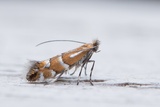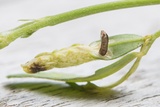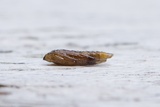Phyllonorycter medicaginella (Gerasimov, 1930) Species
Last modified: Dec. 14, 2024, 4:18 p.m.
This rare and local, xerothermic species was recorded for the first time in Belgium in 2000, in northeast LI. In 2001 the species had already colonized the whole country. As with many Gracillariidae, the species is easily detected by looking for mines on the larval host plant.
Details
- Classification
- Family: Gracillariidae > Subfamily: Lithocolletinae > Genus: Phyllonorycter > Species: Phyllonorycter medicaginella
- Vernacular names
- Honingklavervouwmot (NL), Steinklee-Blattminiermotte (DE)
- First mention in Belgium
- Kuchlein J. H., Kuchlein-Nijsten C. & De Prins W. 2002. Phyllonorycter medicaginella, nieuw voor de Belgische fauna (Lepidoptera: Gracillariidae). — Phegea 30(3): 89–94. On page 89. view page
- Status
-
Native
Distribution
Imago
Head dark brown to blackish; forewing ground color golden brown; white pattern consisting of a rather short basal line, finely edged with brown scales, a transversal line (formed by merging the first costal and dorsal striae), two (rarely three) costal and two dorsal striae, all except the most apical ones, finely edged with brownish scales. A conspicuous black dot in the apical area.
Mine
A white tentiform mine on the underside of a leaf. In later stages, the mine occupies the entire leaf area, and on the underside many small longitudinal folds close to each other. At the end the leaf curls completely over the mine and the caterpillar has consumed all the parenchyma, coloring the mine completely white so that it resembles much like a white pod. The frass is concentrated in a corner of the mine.
See also gracillariidae.net and bladmineerders.be.
Bionomics
Pupation inside the loose spinning in the mine. The species hibernates in the pupal stage. After the emergence of the adult, the pupal skin protrudes from the mine.
Flight periods
The adults fly in several undefined generations a year from May till late September.
Observed on
- Host plant (species):
- Melilotus albus
- Host plant (genera):
- Medicago and Melilotus
The larva lives in on different species Melilotus, especially M. albus, and Medicago.
Habitat
Road sides, ruderal places.



